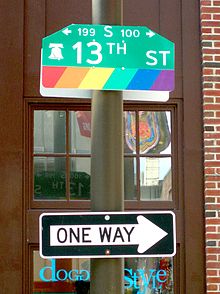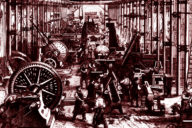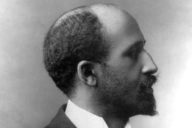By MARCO ROTH
 The old man stands motionless, feet shoulder-width apart, atop the steam grate at the back of the convenience store on the 13th street side. He maintains a fixed expression, eyes locked on a point always beyond any curious passers-by, oblivious to them and to cars. Even the sirens of ambulances and police cruisers leave him unmoved. He stares out beneath thick iron-gray brows like someone on the crow’s nest of a ship or surveying a battlefield; the comparison is suggested by his facial resemblance to a late, minor Roman Emperor—a Geta or Trebonius Gallus—the prominent hooked nose and the high dome of his bald head, the flesh sagging into jowls beneath his high cheekbones. His dignified features are not matched by his clothes: checked golfing pants hitched high above the waist and belted, a white undershirt exposed underneath an unzipped beige windbreaker or unbuttoned polyester bowling shirt with a printed design. He stands over the grate in such a way that the warm air blows up the shirt or jacket, whatever he’s wearing that day, making it plump out behind him, more like a pillow or parachute than a cape. It recalls a children’s bouncy castle at a street fair. Hours at a time this man stands like this—mornings as people bustle on their way to work and school, afternoons as students from the nearby art college hang out and smoke in front of the store, evenings as the transvestite sex workers and their clients drift down from the Camden Patco station.
The old man stands motionless, feet shoulder-width apart, atop the steam grate at the back of the convenience store on the 13th street side. He maintains a fixed expression, eyes locked on a point always beyond any curious passers-by, oblivious to them and to cars. Even the sirens of ambulances and police cruisers leave him unmoved. He stares out beneath thick iron-gray brows like someone on the crow’s nest of a ship or surveying a battlefield; the comparison is suggested by his facial resemblance to a late, minor Roman Emperor—a Geta or Trebonius Gallus—the prominent hooked nose and the high dome of his bald head, the flesh sagging into jowls beneath his high cheekbones. His dignified features are not matched by his clothes: checked golfing pants hitched high above the waist and belted, a white undershirt exposed underneath an unzipped beige windbreaker or unbuttoned polyester bowling shirt with a printed design. He stands over the grate in such a way that the warm air blows up the shirt or jacket, whatever he’s wearing that day, making it plump out behind him, more like a pillow or parachute than a cape. It recalls a children’s bouncy castle at a street fair. Hours at a time this man stands like this—mornings as people bustle on their way to work and school, afternoons as students from the nearby art college hang out and smoke in front of the store, evenings as the transvestite sex workers and their clients drift down from the Camden Patco station.
“He says he just likes the feeling,” I overhear Adam, the long-serving barista at “The Last Drop,” telling his hipster friend one afternoon. We’re looking at the guy through the coffee shop’s picture window as he stands at another of his posts, an air vent for a nearby electrical transformer, located against the mural-painted wall of a bar. I’ve also seen him above a subway grate in front of the Starbucks on Broad Street, and a high end restaurant on Spruce. If there’s a pattern, I can’t make it out.
The two guys in the coffee shop shrug and grin a bit nervously. Each of us knows that “liking the feeling” can’t be the whole story: the exhibition is part of it, somehow. Instinctively, we shy away from wanting to know too much. Whatever drives an old man to stand above these rusted grilles so his shirt pillows oddly behind him, a vacant look of satisfaction in his eyes, the answer can only be banal or terrible, or terrible because banal—some warning from a ghost of future senility. “God, to end up like that!” is the unexpressed thought forming in each of our minds as we watch from the coffee counter.
It’s been three years that I’ve seen this man. He appears unchanged, although he’s added a new shirt, this year, a pointilist confection of red, pink, green, and white dots arranged in some vaguely eastern motif; his expression verges closer to idiocy now, his mouth moving as if he were chewing something tough. I confess I have little curiosity about his origins, whether he still has a family, how he eats, whether dressing himself is the only thing he can still do. Oddly, I’ve never seen him walk. I only meet him already in position, like a living totem. I’ve come to consider him a feature of the urban landscape, and that’s how he interests me, as a fixture: what his presence, his endurance signifies, alongside the presence of others.
Vent man has an anti-type, who is as manic and full of energy as vent man is phlegmatic: the schizophrenic Korean kid—no longer such a kid, really, but arrested at the moment of adolescent rebelliousness. He acts out a ritualistic parody of petulance, spitting, cursing, hissing, stomping the streets in rage. His clothing is similarly aggressive and outrageous, a kind of Korean punk nationalism, all blue, white, orange, and red—almost like a baseball uniform when seen at a distance. Nearly every inch is covered in patches, buttons, drawings, scribbles, just as his exposed arms are fully inked in Yakuza-style tattoos. On the occasions I’ve been close enough to read the messages, without being spat at or cursed out, I notice they say things like “Stop Animal Cruelty,” printed inside a stop sign, “I Heart My Yorkies,” in the manner of “I Heart New York,” or découpaged photos of the two Yorkshire terriers that keep him constant company as he stalks through the neighborhood. Their relationship is thoroughly symbiotic; without them is when he’s at his worst. What seems like fluttering blue and white flags sticking out from his waist are, in fact, a baroque assemblage of bags for picking up dog shit.
He also used to have a bicycle that he’d Mad-Maxed into an aluminum-foil-duct-tape-wrapped spaceship, bulging with useless radials, an antique boom-box fixed in place on the rear rack. He’d ride it exclusively on the narrow sidewalks, or would nose it along, poking at pedestrians, wearing a helmet similarly caparisoned with foil, stickers, and twin antennae. This may explain why he no longer has the bicycle and now spends his afternoons—when not with the dogs—drawing manga cartoons at one of the outdoor tables provided by the Korean deli on the corner of the street where I live. The couple who own the place tolerate him. They feel responsible. It’s strange to think that these are the same people who post signs urging customers to protest against the proposed soda tax intended to benefit the broken down and defunded Philadelphia public school system. “Very bad for business,” the husband tells me, “people will just go to Delaware, New Jersey, or to the suburbs to buy in bulk.” I want to point out that they’re running a convenience store, not a supermarket. Their customers are a mostly captive audience of locals grabbing bagels and sandwiches, and hopeless slaves to routine like me. We’ll all pay more, grudgingly, but ultimately we’ll pay. Instead, I’m struck into silence by how their altruism remains at the level of the parish. Even though this guy is undeniably also bad for business—I’ve seen potential customers turn around at the sight of him—he’s treated as a part of their community in a way that the schoolchildren of Philadelphia are not.
It shouldn’t come as a surprise that one can act with sympathy toward the mentally ill or toward small dogs while being generally suspicious of larger socially ameliorative projects, or inclined to deliver stiffly raised middle-fingers to one’s fellow humans. But this divide in charitable sensibility between local parishioners and urban planners and politicians is a longstanding one—at least as far back as late 18th century British poor relief laws, which proposed putting all indigents, vagrants, beggars, and those without useful occupations into workhouses, for their own good and the good of the economy, and occasioned the poet William Wordsworth’s impassioned argument for letting beggars roam free, in order to allow those only slightly more fortunate a suitable object for their compassion and sympathetic attention—and it will not be resolved anytime soon on the 21st century streets of the City of Brotherly Love. My own interest in “the Korean from outer space” is not particularly rooted in sympathy. I have no real desire to know more about his family history, his medication schedule. He doesn’t want or depend upon my charity or my notice, except in the sense that he invites attention in order to punish anyone who bestows it. That I even learned his name by coincidence—it’s “Mitch”—strikes me as too much information. Like the old man and his air currents, Mitch lives in the collective mind of the neighborhood as a subject of shared fascination.
Taken together, these two types, occupying the same territory of four square blocks and small alleys, give the neighborhood a certain vibe, or energy. They are, in the old Romantic phrase, genii loci, spirits of the place. They create a mood as much as any building, storefront, or structure. While it might seem cold to treat these characters as a kind of living architecture—shrines to their own aberrancy—seeing them in this way also strikes me as the opposite of “dehumanizing.” They are not problems to be solved with better care for the aging, or investment in mental hospitals. Their persistence, even their relative health, these are indications of the kind of world my neighborhood is.
The dynamics these characters bring to the streets, the responses they call forth—wonder, anxiety, intimations of an anger or sadness in human life that endures at a level deeper than will or intention—all this testifies to a fortunate failure of a familiar pattern of hyper-gentrification that was supposed to have taken hold in places like this one. The neighborhood has all the solidly quaint, mixed-use, “structurally” (although not particularly ethnically) diverse markers of a post-industrial American city ripe for expensively appointed revival. From an architectural and sociological standpoint, this area is almost an exact homologue of New York’s Greenwich Village. And yet it has remained perennially “on the cusp” of gentrification ever since I moved here over ten years ago. It hasn’t been for lack of effort on the part of city politicians, landlords, and developers, but the models of high end development that worked in New York or San Francisco haven’t grafted as well as might have been anticipated. Restaurants are replaced by other restaurants, the antique shops gave way to pet shops; the same barbers, orthotics suppliers, and hardware stores now coexist with the “primping economy” of blow dry bars, high end nail salons, and yoga for pregnant women. The gay community has grown grayer, but they haven’t moved out. Many of them own their homes and local businesses, which has prevented the rent-driven rainbow flight from New York’s Village and, later, Chelsea. Each year, a new population of medical students and art students rent the same set of apartments in converted townhouses. Each year, another young couple with kids, having stuck around for the infant yoga program, decides to move to the suburbs to take advantage of their better-funded and more affordable schools.
The neighborhood belies the promised blitzkrieg of progress, although it might be better to think of its stasis as a more sustainable form of it, a limited triumph. People here carry on medievally, the same gestures carried out by the same actors, often. Our lives are a more normalized version of the two spirits. We like the feeling of going to the corner store, regardless of the prices. Or we curse out our neighbors, to their backs, when they double park their cars in the bike lane, fail to clean up after their dogs, or scream at their lovers in the streets. Or we make art the way that spiders weave their webs and birds build their nests. What I’m describing isn’t new, it’s a form of provincialism, the eternal village of Balzac’s “Country Doctor” or Tolstoy’s peasantry, a world outside of productive time, of maximally utilized space. Transposed to the city, however, one feels it with a shock of atavism, the way it felt to watch a homeless man calmly taking a dump in front of a new gastropub. This is the idiocy of urban life, as Marx could never have imagined it, since, for him, cities were, in theory, perpetual dynamos.
The qualities of space and time that open up in the presence of the two totems are both uniquely of the city and opposed to it. Their modes of existence—senescent exhibitionism, spiraling, self- consuming creativity and aggression—couldn’t be sustained anywhere other than an urban space. Where else, at a minimum, would the old man find so many air ducts! Where else would there be a public for him to ignore, or for the Korean Caliban to curse? In the same breath, however, they resist utterly any attempt to join the public life of the city, to be made into sentimental types, emissaries from the good old days, carnival figures of endearing quirkiness. They circulate outside normal modes of recognition, as garish reminders of an older truth from a darker time. They’re enduringly broken in a way that life isn’t meant to be, but often is.
***
Marco Roth is a founding editor of the journal n+1 and the author of The Scientists: A Family Romance (FSG, 2012), in Francesco Pacifico’s incomparable Italian as Gli Scienziati (Indiana Editore). He lives in Philadelphia.






No Comments